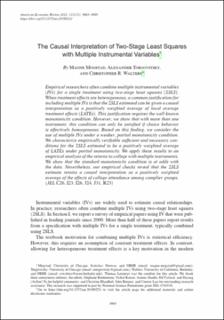| dc.contributor.author | Mogstad, Magne | |
| dc.contributor.author | Torgovitsky, Alexander | |
| dc.contributor.author | Walters, Christopher R. | |
| dc.date.accessioned | 2023-03-02T11:55:16Z | |
| dc.date.available | 2023-03-02T11:55:16Z | |
| dc.date.created | 2021-12-02T15:53:18Z | |
| dc.date.issued | 2021 | |
| dc.identifier.citation | The American Economic Review. 2021, 111 (11), 3663-3698. | |
| dc.identifier.issn | 0002-8282 | |
| dc.identifier.uri | https://hdl.handle.net/11250/3055325 | |
| dc.description.abstract | Empirical researchers often combine multiple instrumental variables (IVs) for a single treatment using two-stage least squares (2SLS). When treatment effects are heterogeneous, a common justification for including multiple IVs is that the 2SLS estimand can be given a causal interpretation as a positively weighted average of local average treatment effects (LATEs). This justification requires the well-known monotonicity condition. However, we show that with more than one instrument, this condition can only be satisfied if choice behavior is effectively homogeneous. Based on this finding, we consider the use of multiple IVs under a weaker, partial monotonicity condition. We characterize empirically verifiable sufficient and necessary conditions for the 2SLS estimand to be a positively weighted average of LATEs under partial monotonicity. We apply these results to an empirical analysis of the returns to college with multiple instruments. We show that the standard monotonicity condition is at odds with the data. Nevertheless, our empirical checks reveal that the 2SLS estimate retains a causal interpretation as a positively weighted average of the effects of college attendance among complier groups. | |
| dc.language.iso | eng | |
| dc.title | The causal interpretation of two-stage least squares with multiple instrumental variables | |
| dc.type | Peer reviewed | |
| dc.type | Journal article | |
| dc.description.version | publishedVersion | |
| dc.source.pagenumber | 3663-3698 | |
| dc.source.volume | 111 | |
| dc.source.journal | The American Economic Review | |
| dc.source.issue | 11 | |
| dc.identifier.doi | 10.1257/aer.20190221 | |
| dc.identifier.cristin | 1963683 | |
| dc.relation.project | National Science Foundation: SES-1530538 | |
| cristin.ispublished | true | |
| cristin.fulltext | original | |
| cristin.qualitycode | 2 | |
